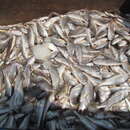Diagnostic Description
provided by FAO species catalogs
Body elongated and compressed. Scales on body mostly ctenoid (comb-like); scales on breast and head smaller and cycloid. Lateral line extending to tip of caudal fin. Head short; eye rather large, its diameter contained 3.6 to 4.6 times in head length; mouth large, strongly oblique, either terminal or lower jaw slightly projecting; maxilla extending beyond hind margin of eye; teeth small, set in narrow bands in jaws; outer row in upper jaw, and inner row in lower jaw slightly enlarged ; chin without barbel but with 6 pores, the medial pair located at tip of lower jaw; snout with 5 marginal pores only. Gillrakers long and slender, longer than gill filaments at angle of arch, 19 to 22 on first gill arch. Preopercular margin serrated, with a few strong spines at angle. Dorsal fin with 10 spines and I + 29 to 34 (usually 31 or 32). Anal fin with 2 spines and 6 soft rays, the second spine very strong, about equal in length to first soft ray. Caudal fin pointed (juveniles) to rhomboidal (adults). Anterior end of swimbladder with one pair of appendages dividing into a group of short anterior branches and a series of 5 or 6 long tubes running backward for about half the length of bladder. Sagitta (earstone) ovoid, thick, twisted around longitudinal axis, its outer surface covered with large granules. Colour silvery grey with a reddish tint often witch oblique lines and scattered dark spots on back; belly yellowish during breeding season; fins greyish; dark spots on soft part of dorsal fin forming 2 or 3 longitudinal rows; tip of first dorsal fin dusky, pelvic and anal fins yellowish.
- Bauchot, M-L. - 1966Poissons marins de l'Est Atlantique Tropical. Téléostéens Perciformes. II. Percoidei (3ème partie). III. Acanthuroidei. IV. Balistoidei. Atlantide Report (9): 7-43.
- Chao, L. N & E. Trewavas. - 1990 Carangidae. In: J.C. Quero et al., (eds.) Check-list of the fishes of the eastern tropical Atlantic (CLOFETA). Unesco, Portugal, vol. II: 813-826.
Distribution
provided by FAO species catalogs
Only along the West African coast, from Senegal to Angola (possibly extending further north).
Size
provided by FAO species catalogs
Maximum 45 cm; common to 30 cm.
Brief Summary
provided by FAO species catalogs
Coastal waters over mud bottomfrom shoreline to about 50 m depth;also enters estuaries and coastal lagoons;moves farther offshore (to about 100 m) for spawning during rainy season (December to February).
Benefits
provided by FAO species catalogs
An important foodfish. Caught with bottom trawls, set nets, beach seines and on line gear. The total catch reported for this species to FAO for 1999 was 6 679 t. The countries with the largest catches were Guinea (2142 t) and Cameroon (1 900 t). Marketed fresh, dried salted and smoked.

